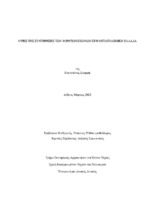| dc.contributor.advisor | Mastrotheodoros, Georgios P. | |
| dc.contributor.author | Στριμπή, Παναγιώτα | |
| dc.date.accessioned | 2023-03-30T12:08:02Z | |
| dc.date.available | 2023-03-30T12:08:02Z | |
| dc.date.issued | 2023-03-30 | |
| dc.identifier.uri | https://polynoe.lib.uniwa.gr/xmlui/handle/11400/4123 | |
| dc.identifier.uri | http://dx.doi.org/10.26265/polynoe-3962 | |
| dc.description.abstract | Στην παρούσα εργασία πραγματοποιείται ιστορική αναδρομή στη συντήρηση των
φορητών εικόνων στην Μεταπολεμική Ελλάδα. Αρχικά, συζητώνται οι πρώτες προσπάθειες
αποκατάστασης των φθορών των εικόνων καθώς και η συγκρότηση των πρώτων εργαστηρίων
συντήρησης στην Αθήνα στο Εθνικό Αρχαιολογικό Μουσείο και στο Βυζαντινό και Χριστιανικό
Μουσείο. Στην συνέχεια, αναλύονται οι συνθήκες και τα στάδια της θεσμοθέτησης της
συντήρησης από το 1974 και μετά. Συγκεκριμένα, περιγράφεται η οργάνωση των εργαστηρίων
συντήρησης και η εκπαίδευση των νέων συντηρητών, ενώ ιδιαίτερη έμφαση δίνεται στο έργο
δύο ηγετικών μορφών στο χώρο της συντήρησης στον ελλαδικό χώρο, του Τάσου Μαργαριτώφ
και του Σταύρου Μπαλτογιάννη. Αμφότεροι αποτελούν τους δύο πρώτους πτυχιούχους Έλληνες
συντηρητές –με πτυχία από πανεπιστήμια του εξωτερικού– οι οποίοι με τις γνώσεις, την όρεξη
και την επιμονή τους επιτυγχάνουν να εκσυγχρονίσουν σημαντικά τον κλάδο. Τέλος, οι
σπουδαίοι συντηρητές Στέργιος Στασινόπουλος και Θάλεια Παπαγεωργίου μιλούν στην
γράφουσα για την δική τους εμπειρία στην συντήρηση από τη δεκαετία του 70’ και μετά
εμπλουτίζοντας έτσι με σημαντικότατα στοιχεία τα προηγουμένως αναφερθέντα ιστορικά
στοιχεία. Συνεπώς, στόχοι της εργασίας αυτής, είναι, αρχικά, η κατανόηση των ιστορικών
δεδομένων που καθόρισαν την μετάβαση από την καθαρά εμπειρική επέμβαση στις εικόνες
μέχρι την επιστημονική συντήρηση και, δεύτερον και κυριότερον, η ανασκόπηση και διεύρυνση
αυτών των δεδομένων μέσω της συλλογής πρωτογενών πληροφοριών από τις δύο ληφθείσες
συνεντεύξεις. | el |
| dc.format.extent | 99 | el |
| dc.language.iso | el | el |
| dc.publisher | Πανεπιστήμιο Δυτικής Αττικής | el |
| dc.rights | Αναφορά Δημιουργού - Μη Εμπορική Χρήση - Παρόμοια Διανομή 4.0 Διεθνές | * |
| dc.rights | Attribution-NonCommercial-NoDerivatives 4.0 Διεθνές | * |
| dc.rights.uri | http://creativecommons.org/licenses/by-nc-nd/4.0/ | * |
| dc.subject | Συντήρηση έργων τέχνης | el |
| dc.subject | Φορητές εικόνες | el |
| dc.subject | Ιστορία συντήρησης | el |
| dc.subject | Μεταπολεμική Ελλάδα | el |
| dc.title | Όψεις της Συντήρησης των Φορητών Εικόνων στη Μεταπολεμική Ελλάδα | el |
| dc.title.alternative | Aspects to Icon Conservation in Post-War Greece | el |
| dc.type | Πτυχιακή εργασία | el |
| dc.contributor.committee | Φάρδη, Θεοδώρα | |
| dc.contributor.committee | Χατζηδάκη, Μαρία | |
| dc.contributor.faculty | Σχολή Εφαρμοσμένων Τεχνών & Πολιτισμού | el |
| dc.contributor.department | Τμήμα Συντήρησης Αρχαιοτήτων και Έργων Τέχνης | el |
| dc.description.abstracttranslated | This essay presents a historical overview of icon conservation in Post-War Greece.
Firstly, I discuss the first attempts at icon restoration to be observed in Greece as well as the
formation of the first art conservation laboratories in Athens in the National Archaeological
Museum and the Byzantine and Christian Museum. What follows is the analysis of the
conditions under which art conservation became established as a professional as well as
scientific field in 1974. Precisely, I describe the process of organizing art conservation labs as
well as that of educating and training younger conservators and technicians and I, also, pay
tribute to the work of the first two Greek conservators with higher education degrees in
conservation –which were obtained in Italy. Tassos Margaritoff and Stavros Baltogiannis, both
leading figures in conservation, returned to Greece with great passion and significant knowledge
and succeeded in modernizing and advancing conservation practices. Lastly, I interview
influential conservators Stergios Stassinopoulos and Thaleia Papageorgiou whose account on
their own experience and work in conservation starting in the 1970s and moving forward
enriches the historical data presented earlier in the paper. Overall, this essay attempts to, firstly,
unpack the historical moments that determined the transition from purely experiential restoration
to scientific conservation and, secondly –and most importantly– to assess the discussed historical
data in relation to the first hand material gathered from the two interviews. | el |


